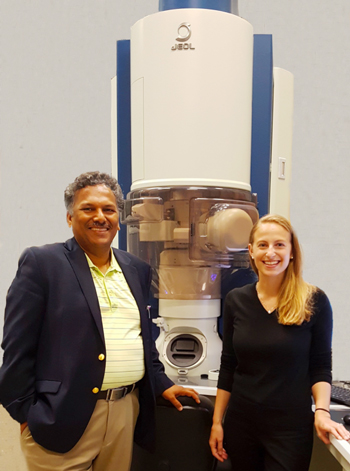Researchers Challenge Status Quo of Battery Commercialization
Following the pharma model holds promising potential to spur battery innovation and bring transformative technologies to market
While more efficient, effective, and economical batteries are critical to the world’s clean energy future, the path to bringing such technologies to market over the last 25 years is overwhelmingly littered with failure.
A pair of Northwestern University researchers and a Northwestern-affiliated startup, however, are touting a different way and have pulled inspiration from a seemingly unlikely place: the pharmaceutical world.
In a recent paper published in MRS Energy & Sustainability, Vinayak Dravid, the Abraham Harris chaired professor of materials science and engineering at Northwestern’s McCormick School of Engineering, his graduate student Eve Hanson, and SiNode Systems co-founder and CEO Samir Mayekar propose an updated model of U.S. battery commercialization.
 The model is informed by pharma, an industry that faces many similar commercialization challenges yet, unlike energy, boasts a deep history of successful market debuts.
The model is informed by pharma, an industry that faces many similar commercialization challenges yet, unlike energy, boasts a deep history of successful market debuts.
As the head of Chicago-based SiNode Systems, Mayekar confronts the challenges of battery commercialization daily. The startup is commercializing a novel silicon anode technology based on research from the lab of Harold Kung, Walter P. Murphy Professor of Chemical and Biological Engineering, but faces daunting technical and market hurdles.
A dual degree holder from Northwestern’s Weinberg College of Art and Sciences and the Kellogg School of Management, Mayekar approached Dravid and Hanson to conduct a formal study of applying the pharma model to energy, believing that incorporating elements of the pharma model into battery commercialization efforts could propel the number of success stories.
“The question was how could we beat the odds and drive the battery innovation ecosystem to be a better version of its current self,” Dravid said. “It is remarkable that Mayekar, a member of the University’s board of trustees, reached out to an enterprising student in his NUvention class (Hanson) to ask her to take on this challenge.”
Studying pharma successes through interviews with industry leaders and investors as well as published reports, Dravid and Hanson noted distinct differences between pharma and energy – namely, pharma being a high-margin business compared to the commoditized battery sector – but also striking similarities that could inform energy’s commercialization efforts.
Together with Mayekar, they identified a series of tailored proposals for entrepreneurs, investors, manufacturers, and policy makers to fuel battery commercialization, including:
- Initially pursuing niche, higher-margin applications to bring in early revenue and help prove out the technology
- Developing strategic partnerships and joint development agreements with large battery companies to enhance credibility, certify data, and consider how technologies might be manufactured and integrated into the supply chain
- Targeting capital raises to specific exit scenarios to enhance investor returns and better align with the battery market’s realities
- Focusing on customer-led performance metrics, rather than academic figures of merit, as early as possible to more fully understand the market opportunity
With more economical and energy-dense batteries holding the potential to solve contemporary energy challenges – such as balancing the intermittency problems of renewables and making possible electric transportation fleets – the researchers believe applying the pharma-inspired development pipeline to batteries can breed rich, transformative technologies.
“We think this is a way for more battery startups to succeed,” Hanson said. “Bringing more innovative battery technologies to market would have impacts across the clean energy and electronics industries. Perhaps even more important is this core idea of multidisciplinary approach to address complex technological challenges that require diverse perspectives and expertise.”